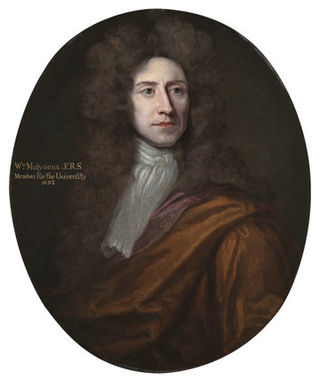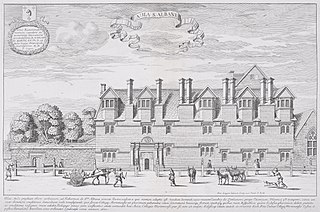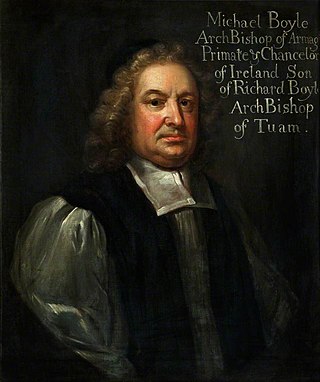
The University Philosophical Society, commonly known as The Phil, is a student paper-reading and debating society in Trinity College, Dublin, Ireland. Founded in 1683 it describes itself as the oldest student, collegial and paper-reading society in the world.

William MolyneuxFRS was an Anglo-Irish writer on science, politics and natural philosophy.

St Alban Hall, sometimes known as St Alban's Hall or Stubbins, was one of the medieval halls of the University of Oxford, and one of the longest-surviving. It was established in the 13th century, acquired by neighbouring Merton College in the 16th century but operated separately until the institutions merged in the late 19th century. The site in Merton Street, Oxford, is now occupied by Merton's Edwardian St Alban's Quad.
Events from the year 1683 in Ireland.

Lieutenant General Sir Thomas Molyneux, 1st Baronet FRS was an Irish physician.

Charles Graves was an Irish mathematician, academic, and clergyman. He was Erasmus Smith's Professor of Mathematics at Trinity College Dublin (1843–1862), and was president of the Royal Irish Academy (1861–1866). He served as dean of the Chapel Royal at Dublin Castle, and later as Bishop of Limerick, Ardfert and Aghadoe. He was the brother of both the jurist and mathematician John Graves, and the writer and clergyman Robert Perceval Graves.

Kilkenny College is a Church of Ireland co-educational day and boarding secondary school located in Kilkenny, in the South-East of Ireland. It is the largest co-educational boarding school in Ireland. In 2013 it transferred to the state/public sector and no longer charges fees for schooling. The school's students are mainly Protestant, although it is open to other denominations.

The School of Medicine at Trinity College in Dublin, Republic of Ireland, is the oldest medical school in Ireland. Founded in the early eighteenth century, it was originally situated at the site of the current Berkeley Library. As well as providing an undergraduate degree in medicine, the school provides undergraduate courses in physiotherapy, occupational therapy, radiation therapy, human nutrition & dietetics and human health & disease, over 20 taught postgraduate courses, and research degrees.

Sir Henry Marsh, 1st Baronet was an Irish physician and surgeon. He was born in Loughrea, County Galway in Ireland. He was one of the medical doctors associated with Basedow's syndrome, which is also known as Marsh's disease and currently as Graves' disease.
Sir Richard Bulkeley, 2nd Baronet FRS was an Irish politician and baronet.

Michael Boyle, the younger was a Church of Ireland bishop who served as Archbishop of Dublin from 1663 to 1679 and Archbishop of Armagh from 1679 to his death. He also served as Lord Chancellor of Ireland, the last time a bishop was appointed to that office.

St. George Ashe, D.D. was an Irish mathematician who served as the 15th Provost of Trinity College Dublin from 1692 to 1695. In the late 17th and early 18th centuries, he served as Church of Ireland Bishop of Cloyne, Clogher and Derry, in succession. From 1685 to 1692, he was the Donegall Lecturer in Mathematics at Trinity College Dublin. He is remembered now chiefly for his alleged role in performing a secret marriage between Jonathan Swift and Esther Johnson (Stella).

Humphrey Lloyd FRS FRSE MRIA was an Irish physicist and academic who served as the 30th Provost of Trinity College Dublin from 1867 to 1881. He was Erasmus Smith's Professor of Natural and Experimental Philosophy at Trinity College Dublin from 1831 to 1843. Lloyd is known for experimentally verifying conical refraction, a theoretical prediction made by William Rowan Hamilton about the way light is bent when travelling through a biaxial crystal. He was a Fellow of the Royal Society, and President of both the British Association and the Royal Irish Academy.
John Garnett (1707/08–1782) was an English bishop of Clogher in the Church of Ireland.
Anthony Dopping was the Anglican Bishop of Meath, Ireland.
Thomas Molyneux, or Molinel (1531–1597) was a French-born English statesman, who held high office in Ireland during the Elizabethan era. He founded a dynasty which produced several distinguished members, and became the Molyneux baronets of Castle Dillon, County Armagh.
Dr. Patrick Sheridan was the Church of Ireland Bishop of Cloyne between 1679 and 1682.

















